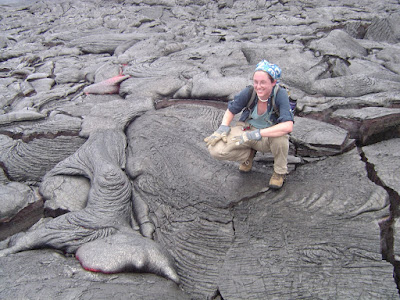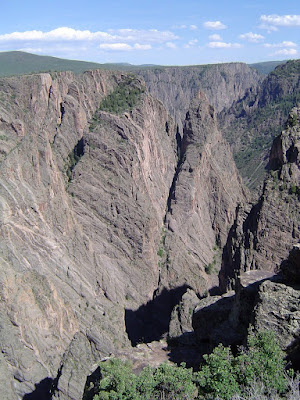1. See an erupting volcano

3. See an active geyser such as those in Yellowstone, New Zealand or the type locality of Iceland
4. Visit the Cretaceous/Tertiary (KT) Boundary. Possible locations include Gubbio, Italy, Stevns Klint, Denmark, the Red Deer River Valley near Drumheller, Alberta. - I've sat on it - or at least very close to it - in Big Bend National Park. See the Ks and Ts? Yeah, we were all dorks.

6. Explore a limestone cave. Try Carlsbad Caverns in New Mexico, Lehman Caves in Great Basin National Park, or the caves of Kentucky or TAG (Tennessee, Alabama, and Georgia) - I've made it to Carlsbad, Mammoth Caves and various small ones in Virginia.
7. Tour an open pit mine, such as those in Butte, Montana, Bingham Canyon, Utah, Summitville, Colorado, Globe or Morenci, Arizona, or Chuquicamata, Chile.
8. Explore a subsurface mine.
9. See an ophiolite, such as the ophiolite complex in Oman or the Troodos complex on the Island Cyprus (if on a budget, try the Coast Ranges or Klamath Mountains of California).
10. An anorthosite complex, such as those in Labrador, the Adirondacks, and Niger (there's some anorthosite in southern California too).
11. A slot canyon. Many of these amazing canyons are less than 3 feet wide and over 100 feet deep. They reside on the Colorado Plateau. Among the best are Antelope Canyon, Brimstone Canyon, Spooky Gulch and the Round Valley Draw. - Lots of these in various places out West.

13. An exfoliation dome, such as those in the Sierra Nevada.
14. A layered igneous intrusion, such as the Stillwater complex in Montana or the Skaergaard Complex in Eastern Greenland.
15. Coastlines along the leading and trailing edge of a tectonic plate (check out The Dynamic Earth - The Story of Plate Tectonics - an excellent website).
16. A ginkgo tree, which is the lone survivor of an ancient group of softwoods that covered much of the Northern Hemisphere in the Mesozoic.
17. Living and fossilized stromatolites (Glacier National Park is a great place to see fossil stromatolites, while Shark Bay in Australia is the place to see living ones) I can only claim half of this one, but I saw some fantastic stromatolites on the Niagara Escarpment near Lockport.

19. A caldera

21. A fjord
22. A recently formed fault scarp - Wait, define "recently" - we're geologists, after all. Recently could mean a few million years ago.
23. A megabreccia
24. An actively accreting river delta
25. A natural bridge
26. A large sinkhole
27. A glacial outwash plain
28. A sea stack
29. A house-sized glacial erratic
30. An underground lake or river
31. The continental divide

33. Petrified trees - At Petrified Forest National Park, where you get in serious trouble just for touching one, and about five minutes outside the park, where no one cares.


36. Meteor Crater, Arizona, also known as the Barringer Crater, to see an impact crater on a scale that is comprehensible (and it is quite BIG)
37. The Great Barrier Reef, northeastern Australia, to see the largest coral reef in the world.
38. The Bay of Fundy, New Brunswick and Nova Scotia, Canada, to see the highest tides in the world (up to 16m)
39. The Waterpocket Fold, Utah, to see well exposed folds on a massive scale.
40. The Banded Iron Formation, Michigan, to better appreciate the air you breathe.
41. The Snows of Kilimanjaro, Tanzania,
42. Lake Baikal, Siberia, to see the deepest lake in the world (1,620 m) with 20 percent of the Earth's fresh water.
43. Ayers Rock (known now by the Aboriginal name of Uluru), Australia. This inselberg of nearly vertical Precambrian strata is about 2.5 kilometers long and more than 350 meters high
44. Devil's Tower, northeastern Wyoming, to see a classic example of columnar jointing
45. The Alps.
46. Telescope Peak, in Death Valley National Park. From this spectacular summit you can look down onto the floor of Death Valley - 11,330 feet below.
47. The Li River, China, to see the fantastic tower karst that appears in much Chinese art
48. The Dalmation Coast of Croatia, to see the original Karst.
49. The Gorge of Bhagirathi, one of the sacred headwaters of the Ganges, in the Indian Himalayas, where the river flows from an ice tunnel beneath the Gangatori Glacier into a deep gorge.
50. The Goosenecks of the San Juan River, Utah, an impressive series of entrenched meanders.
51. Shiprock, New Mexico, to see a large volcanic neck - Even if the van was traveling 60 mph at the time, I still saw it!

53. Tierra del Fuego, Chile and Argentina, to see the Straights of Magellan and the southernmost tip of South America.
54. Mount St. Helens, Washington, to see the results of recent explosive volcanism. - Maybe this summer!
55. The Giant's Causeway and the Antrim Plateau, Northern Ireland, to see polygonally fractured basaltic flows.
56. The Great Rift Valley in Africa.
57. The Matterhorn, along the Swiss/Italian border, to see the classic "horn".
58. The Carolina Bays, along the Carolinian and Georgian coastal plain
59. The Mima Mounds near Olympia, Washington
60. Siccar Point, Berwickshire, Scotland, where James Hutton (the "father" of modern geology) observed the classic unconformity
61. The moving rocks of Racetrack Playa in Death Valley
62. Yosemite Valley
63. Landscape Arch (or Delicate Arch) in Utah
64. The Burgess Shale in British Columbia - Only the display at the Smithsonian.
65. The Channeled Scablands of central Washington
66. Bryce Canyon
67. Grand Prismatic Spring at Yellowstone
68. Monument Valley
69. The San Andreas fault
70. The dinosaur footprints in La Rioja, Spain
71. The volcanic landscapes of the Canary Islands
72. The Pyrennees Mountains
73. The Lime Caves at Karamea on the West Coast of New Zealand
74. Denali (an orogeny in progress)
75. A catastrophic mass wasting event - Only after the fact, in Utah and the Virginia Blue Ridge.
76. The giant crossbeds visible at Zion National Park
77. The black sand beaches in Hawaii (or the green sand-olivine beaches) - Both, baby!

79. Hells Canyon in Idaho
80. The Black Canyon of the Gunnison in Colorado

82. Feel an earthquake with a magnitude greater than 5.0.
83. Find dinosaur footprints in situ
84. Find a trilobite (or a dinosaur bone or any other fossil)
85. Find gold, however small the flake
86. Find a meteorite fragment
87. Experience a volcanic ashfall - Just wait until March!
88. Experience a sandstorm
89. See a tsunami
90. Witness a total solar eclipse
91. Witness a tornado firsthand - I'm pretty sure there was a brief and minor one near our house when I was really little, but we were too busy cowering in the basement to see it.
92. Witness a meteor storm, a term used to describe a particularly intense (1000+ per minute) meteor shower
93. View Saturn and its moons through a respectable telescope. - Does it automatically become respectable if it's most of the way up Mauna Kea?
94. See the Aurora borealis, otherwise known as the northern lights.
95. View a great naked-eye comet, an opportunity which occurs only a few times per century - Hale-Bopp, when I was twelve. Gee, I feel awfully young.
96. See a lunar eclipse - Quite a few of these in the past few years, actually.
97. View a distant galaxy through a large telescope
98. Experience a hurricane - Just a few years ago, in Florida. Weak hurricanes are boring - I think my flight was delayed and I spent the day at the mall.
99. See noctilucent clouds
100. See the green flash
26 out of 100. Well, I certainly don't measure up to most of you all in the geoblogosphere, but I'm still a young'un yet. Besides, I'll be fixing that ash fall and earthquake deficiency when I get to do field work in a couple of months. In fact, my dearth of bolded items is clearly unacceptable, and I'm just going to take a few years and go visit all these places* so I can update this post.
*This, of course, requires money, which I do not have in large amounts. So those few years aren't going to happen anytime soon, darn it.








1 comment:
Give it time! I didn't get to a lot of my localities until I had been teaching a few years and managed to convince the school to let me teach some field course overseas. Thanks for jumping in!
Post a Comment